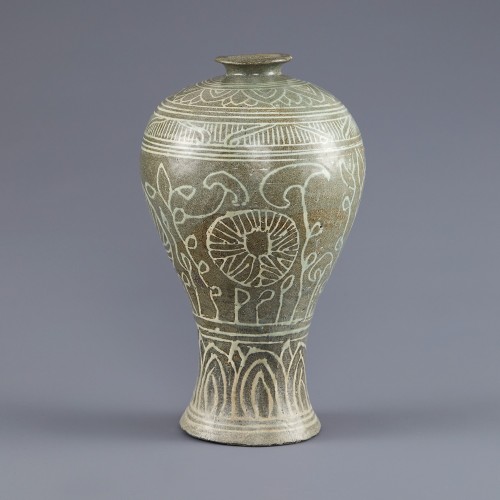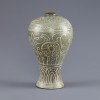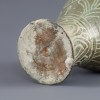본문
조선 전기의 분청자화문매병은 고려 청자의 기법과 형태를 계승하면서도 실용성과 대중적 감각을 바탕으로 새롭게 발전한 양식입니다.
이 유물은 짧고 좁은 구연부, 팽만한 어깨, 하부로 좁아지는 동체 등 조선 초기 매병의 전형적인 형태를 따르며, 안정감 있는 비례를 갖춥니다.
회흑색 태토 위에 백토를 분장하고 꽃과 덩굴무늬를 새긴 후 유약을 입혀 소성하였습니다. 몸체 중앙에는 소용돌이 모양의 원형 화문을 중심으로 덩굴과 잎이 퍼져있고, 이는 생명력과 길상의 의미를 담습니다. 또한 어깨와 하부에는 연판문과 기하문이 반복되며 도식적인 장식미를 더합니다. 회갈색 바탕과 백색 문양이 조화롭게 어우러지며, 자유롭고 대담한 선의 구성은 민화적 감수성과 도공의 창의성을 반영합니다.
이러한 매병은 본래 술이나 물을 담는 일상의 병에 기반하면서도 조형성과 상징성을 함께 지닙니다. 또한 고려 청자의 전통 위에 조선적 감성이 더해진 과도기 도자의 예시로 평가됩니다.
━━━━━
朝鲜前期的粉青花纹梅瓶,是在继承高丽青瓷的技法与造型基础上,结合实用性与大众审美而发展出的新风格。
口沿短而窄,丰肩,肩以下渐收,造型符合朝鲜初期梅瓶的典型特征,整体比例匀称,呈现出稳重感。
器物以灰黑色胎土制成,表面施以白色化妆土,雕刻花卉与藤蔓纹后再施釉烧成。瓶身中央饰有螺旋状的圆形花纹,四周藤蔓与叶片环绕展开,寓意生机与吉祥。肩部与下腹部则反复排列莲瓣纹与几何图案,增添了程式化的装饰美感。灰褐色胎地与白色纹饰之间形成鲜明对比,自由而大胆的线条构图,体现出民画般的感性与陶工的创意表达。
此类梅瓶虽源于日常生活中盛酒或贮水的实用容器,但兼具造型美感与象征意义。亦被视为在高丽青瓷传统之上融入朝鲜审美情感的过渡期陶瓷代表作。
━━━━━
This buncheong maebyeong from early Joseon represents a new stylistic development grounded in practicality and popular aesthetics, while still inheriting the techniques and forms of Goryeo celadon.
The vase has a short, narrow mouth, rounded shoulders, and a gradually narrowing lower body—features characteristic of early Joseon maebyeong. It displays balanced and stable proportions.
On a grayish-black clay body, a white slip was applied, then incised with floral and vine motifs before glazing and firing. At the center of the body, a circular floral pattern radiates outward with vines and leaves, symbolizing vitality and auspiciousness. Lotus petal and geometric motifs decorate the shoulder and lower body, adding a schematic decorative rhythm.
The contrast between the ash-brown background and white motifs creates visual harmony, while the bold, free-flowing lines reflect the folk sensibilities and creative spirit of the potter.
Though rooted in utilitarian use—typically for storing wine or water—this maebyeong also holds symbolic and artistic value. It stands as a transitional piece that blends Goryeo traditions with emerging Joseon aesthetics.


